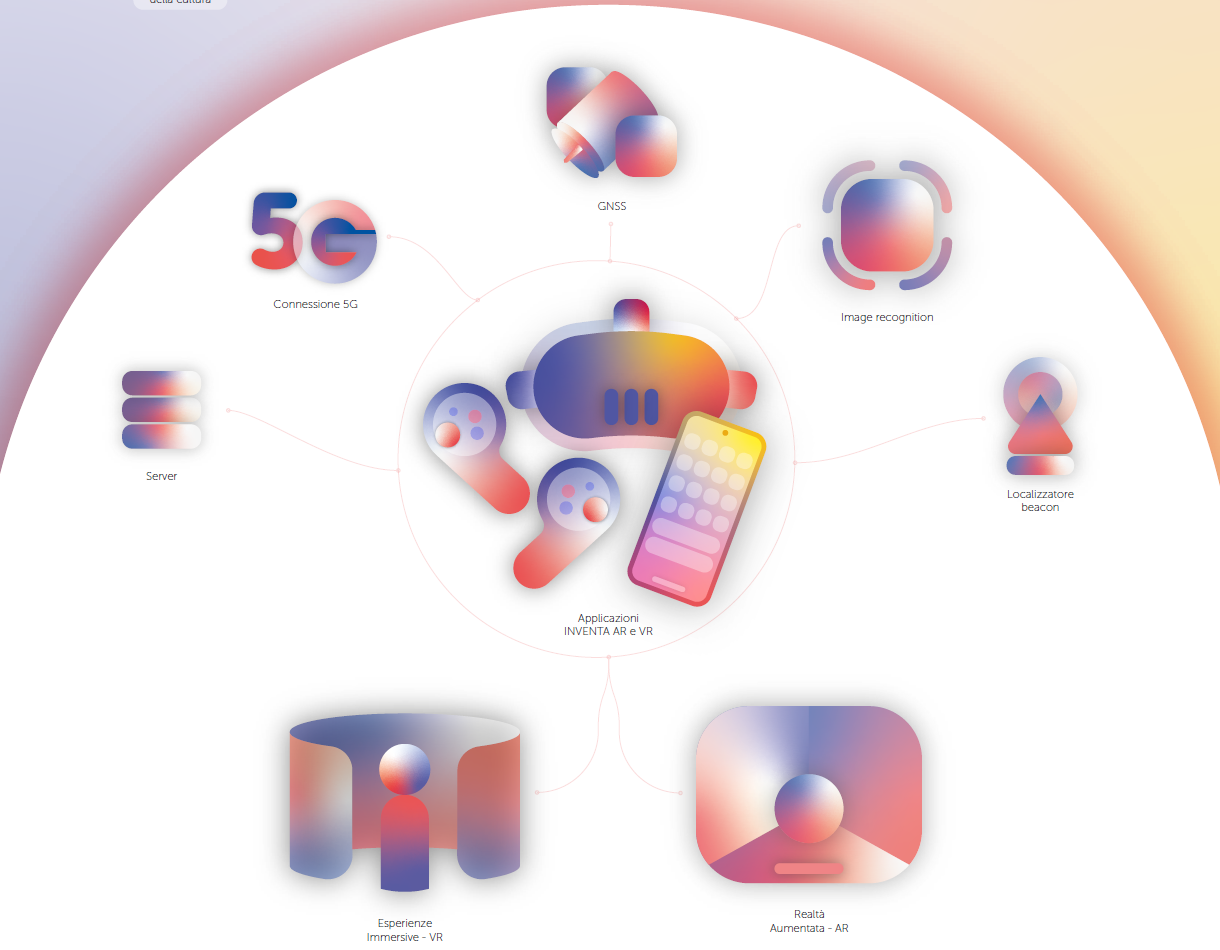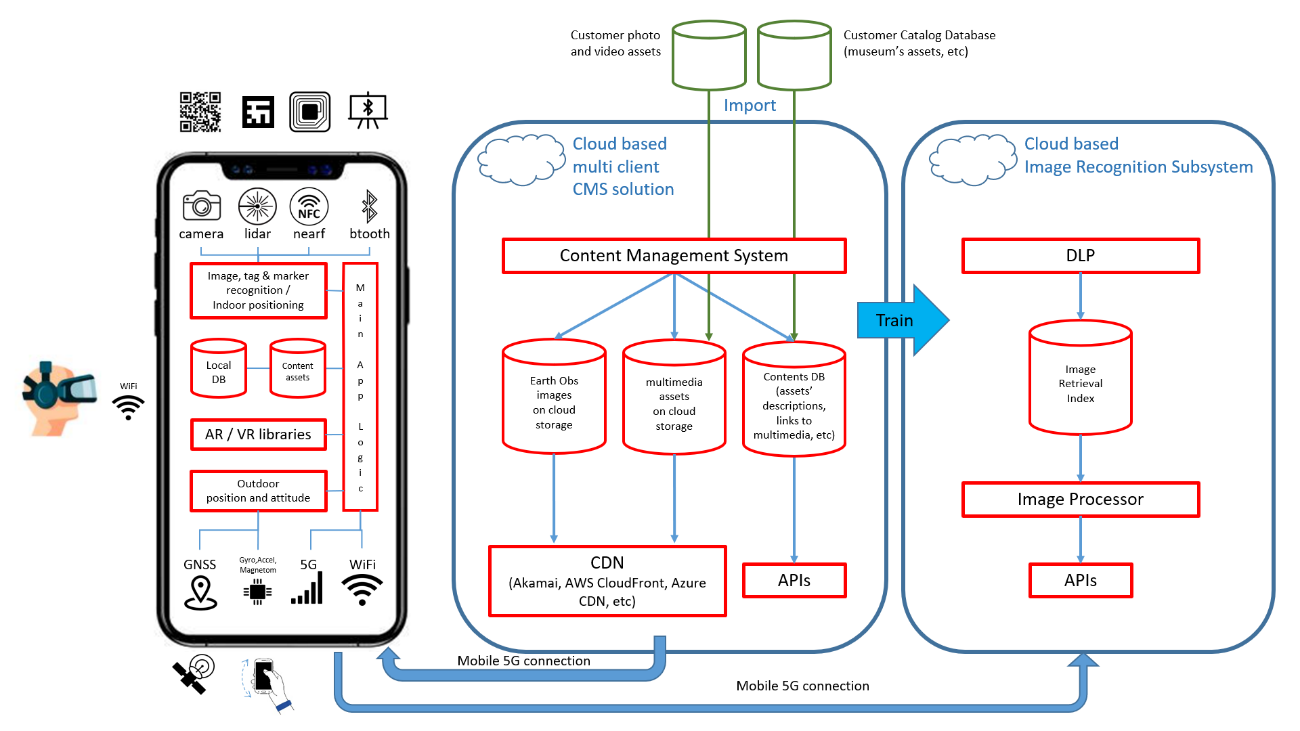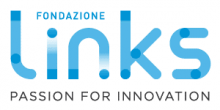
Objectives of the service

Digital technologies are generating a new form of valorization and protection of cultural heritage, whose fruition is no longer tied to a territorial vision, but expands towards new unlimited horizons, free of space-time constraints. It is up to us now to make the most of this possibility.
The INVENTA Project aims to explore the potential of Virtual Reality and Augmented Reality technologies combined with the 5G network and space technology (in particular Satellite Navigation and Earth Observation), to bring innovation in the Cultural Heritage sector, by strengthening the following aspects:
-
Fruition, enriching the visit experiences with innovative, three-dimensional, 360 ° immersive, interactive multimedia contents that can be downloaded anywhere on your mobile device;
-
Accessibility, building visits with interactive guides that can be used remotely, ad-hoc tailored also for the most fragile categories of people including the elderly, disabled people, ill people, hospital patients or people trapped in quarantine by the Covid-19 pandemic;
-
Sustainability, optimizing the management costs of cultural sites by complementing the physical infrastructures (signs, audio-diffusion systems, monitors, etc.) with AR-based digital components, customizable in real time based on contingent information (crowds, queues, local events, promotions, etc.)
INVENTA creates a new way of living the cultural heritage world. The possibility of generating 3D digital content in any place (thanks to the 5G network) and of snapping it to a specific spatial reference context (thanks to space technologies) produces a wide range of possibilities.
First of all, the tourist visits are enriched by extremely engaging innovative experiences, based on augmented / virtual reality technologies and made available directly on people's mobile devices.
Secondly, the possibility of a 3D virtual logistics guide capable of retrieving spatial information in real time significantly increases the economic sustainability of the management processes of cultural sites, reducing the costs of acquiring/installing/maintaining local devices (e.g. audio-guides) and local infrastructures (e.g. signs, monitors), digitally guiding visitors with dedicated real-time updates, announcements of events or time-limited promotions, while regulating their flows and mitigating overcrowding phenomena. Smart services such as free parking guidance are fully managed through the INVENTA app using satellite technology and Augmented Reality, eliminating any cost for physical installations and of course the environmental footprint, and significantly reducing possible traffic congestion.
INVENTA strengthens the possibility of accessing and experiencing cultural heritage even remotely, thus making cultural contexts more inclusive for all people, in particular for protected categories (disabled people, hospital patients, elderly, sick) and makes new business models available for museums, able to reach new groups of visitors, breaking down any geographical barrier.
These models allow not only a more effective response from museums to the current situation of the COVID-19 pandemic, but also relaunch the role of artists, guides and professionals in the cultural heritage sector who transmit their knowledge by interpreting 3D digital avatars within virtual visiting or other multi-user cultural virtual experiences.
Users and their needs
Any stakeholder (museums, tourist agencies, municipalities, temporary exhibitions organizer, etc.) having an interest in promoting any cultural element (sites, monuments, artworks, historical buildings, etc.) is a potential “Customer” of INVENTA Services.
Customers aim at offering more and more competitive visiting experiences, improving the following key aspects:
-
Fruition: enriching visiting experiences with innovative digital material support
-
Accessibility: extending the possibility to access the cultural site to a greater and greater number of people
-
Sustainability: optimizing the resources needed, and/or the related costs, to manage the cultural site
Instead, we use the term “Users”, to refer to the people (individually, or in clusters) who benefit fromthe improved visiting experiences.
As “User” we see any individual who can physically access a cultural site and/or take advantage of any related digital content. Thus, Users can be distinguished into two main categories: “physical visitors” (Tourists, Citizens, etc.) and “remote visitors” (people who cannot physically reach the site, including protected categories such as disabled people, hospital patients, elderly, and people trapped at home by COVID-19 Outbreak). INVENTA considers not only individual users, but also users associated in groups, involving entities such as citizens associations, education institutions, or healthcare centers (who want to allow patients to remotely visit cultural heritage sites).
Service/ system concept

Space Added Value

The INVENTA App downloads and displays AR/VR based content based on the experience logic and UI.
Full integration of the available sensors is provided by the app. Envisioned usage is the following:
-
GNSS: the app leverages localization data to
-
notify the user of specific content available
-
enable gamification features
-
use AR to display POI (Point Of Interest) information
-
enable usage of high precision positioning on dual-frequency HW equipped devices camera, lidar, NFC, Bluetooth: enable indoor positioning and image recognition of masterpieces / cultural assets
-
-
IMU components (such as gyroscope, accelerometer, magnetometer): enable smoother AR behavior and gamification features
-
5G: faster connection speed is leveraged to
-
enable download and fruition of higher quality streaming content such as 360° visualizations of cultural assets
-
enable interactive features for gamification and interaction with museum guides such as live QA
-
The INVENTA app leverages space-derived technologies to enhance cultural heritage experience.
GNSS technology is utilized to provide accurate positioning, enabling the app to detect the user's proximity to Points of Interest (POIs) and trigger the presentation of relevant content, including text, video, Augmented Reality (AR), and Virtual Reality (VR) experiences. This functionality supports innovative outdoor visits, gamified exploration, and enriched cultural discovery for users. The app has been tested to ensure compatibility and accurate performance with various GNSS receivers in smartphones.
The app is designed to function effectively in areas with enhanced broadband connectivity. Performance tests have demonstrated improved data download and upload speeds when using 5G networks compared to 4G. This enhanced connectivity allows for the delivery of richer and more detailed content to users. The app's architecture is also designed to be flexible to accommodate connectivity solutions based on 5G campus networks or other broadband solutions, including satellite-based connectivity.
Current Status
Engagement of the case studies
The INVENTA project's initial proposal outlined four key case studies: Palazzo Madama + SC Neuroriabilitazione; Parco del Valentino and Borgo Medievale; Museo d’Arte Orientale (MAO); and Palazzo Ducale. To maximize the project's impact and demonstrate the versatility of the INVENTA service, the Polo del '900 was included as an additional case study. Ultimately, the Polo del '900 pilot replaced the Parco del Valentino and Borgo Medievale pilots. The successful completion of the pilot stage at these diverse sites (Palazzo Madama + SC Neuroriabilitazione, MAO, Palazzo Ducale, and Polo del '900) represents a major achievement, validating the INVENTA service across various settings.
The key outcomes and KPIs from the pilot stage are summarized below:
-
Città della Salute e della Scienza – SC Neuroriabilitazione
The INVENTA project included a pilot study at SC Neuroriabilitazione, focusing on its use in a healthcare environment. This demonstration took place within the spinal surgery department of "AOU Città Della Salute e Della Scienza" (Turin, Italy), and participants included medical staff, caregivers, and patients. The pilot's results showed a positive outcome, with patients exhibiting an average increase of 2 points on the Coma Recovery Scale.
-
Museo d’Arte Orientale (MAO)
The MAO pilot showcased mixed results. While user participation exceeded the target number of users, with 54 participants compared to the expected 40, user engagement declined significantly after the first week. Average app usage was also lower than anticipated, as users accessed enriched content for only three or four artworks, potentially due to content repetitiveness. Despite this lower usage, user feedback was generally positive, with high satisfaction reported and many users finding the app easy to use and effective for in-depth exploration of the artifacts. The image recognition algorithm's technical performance was generally good, though some challenges arose, including content download issues due to poor network conditions. Finally, user willingness to pay an additional fee for the app was low, with most users believing it should be included in the museum entrance fee.
-
Polo del 900
The pilot at Polo del 900 demonstrated strong user engagement and positive indicators for future sustainability. Key KPIs included growing accessibility, in fact for over 90% of respondents, the pilot made accessible content that would otherwise have been partly or wholly inaccessible for physical reasons or simply lack of time. Moreover, over 80% of respondents stated they would be willing to pay a surcharge on the ticket to access content like that shown in the INVENTA app demonstrator. This data not only confirms one of the pilot's objectives but, also confirms that the in-depth content, when accessed through the immersive Virtual Reality mode, is perceived by the user as a real “premium” content for which they are willing to pay an extra contribution.
-
Palazzo Ducale in Genova (PdG)
Palazzo Ducale in Genova (PdG) pilot successfully assessed the INVENTA app's impact on visitor experience, with a strong focus on user satisfaction. Feedback indicated the app's benefit in guiding visitors and facilitating access to information about events and cultural offerings. The pilot also measured user interaction through immersive content views, demonstrating the app's capacity to enhance engagement. Notably, results showed that 84% of users fully agreed that VR is a powerful tool for increasing museum accessibility, with a significant proportion highlighting that VR enabled them to visit areas otherwise limited by accessibility or time constraints.
Conclusion
In conclusion, the pilot phase of the INVENTA project has been successfully completed, demonstrating the service's effectiveness across diverse settings, from healthcare to cultural heritage. A particularly significant achievement is the sale of the INVENTA app to Palazzo Ducale during the pilot stage, underscoring the solution's market viability and strong potential for commercialization. The INVENTA solution is now poised for commercial rollout, building on the valuable insights and successes of the pilot program.





